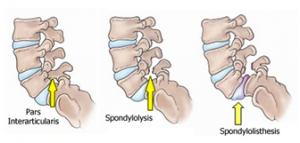Stress fractures of the spine in young athletes
 Stress fractures of the lumbar spine in the young athlete is a common injury you hear of in this population group. Spondylolysis is a condition describing a non displaced stress fracture of the spinal vertebra, in the pars interarticularis of the spinal column. The pars interarticularis is the part of the vertebra between the upper and lower facets of the vertebra. Most cases of spondylolysis occur at the L5 level.
Stress fractures of the lumbar spine in the young athlete is a common injury you hear of in this population group. Spondylolysis is a condition describing a non displaced stress fracture of the spinal vertebra, in the pars interarticularis of the spinal column. The pars interarticularis is the part of the vertebra between the upper and lower facets of the vertebra. Most cases of spondylolysis occur at the L5 level.
There are two primary sources of risk factors for the development of spondylolysis in the young athlete.
Genetics: Some people are predisposed genetically to this condition be it a result of the shape or the strength of the bone, the alignment of the vertebrae or the rate of growth during childhood and adolescence.
Sports activities: Specific sports activities involving hyperextension of the lumbar spine in sports groups such as gymnasts, divers, bowlers in cricket, may make the findings of spondylolysis more prevalent.
The most common signs and symptoms will be reported low back pain in the young athlete (often one sided but can be bilateral), pain may be isolated to the lower back or also may have pain radiating to buttocks or thighs. Pain is often aggravated with lumbar extension (bending backwards ), twisting of the trunk, prolonged standing and high impact activities. Patient will often report pain eases with rest. On examination the patient will often have exaggerated lumbar arch, tight hip flexors, gluts and /or hamstrings. Imaging may be needed to determine this injury and the extent of it, this may include xray, CT scan, bone scan or MRI. Consideration must be given to the necessity of testing and which testing should be chosen to minimise the exposure of the young athlete to radiation.
If the spondylolysis is present on both sides of the spine, it may give rise to a condition called spondylolisthesis where a vertebral body can slip forward over the vertebrae below as a direct result of the stress fracture in the bilateral pars interarticularis causing the spinal column to be come unstable.
Spondylolysis has a good prognosis when treated conservatively and adequate rest given from aggravating activities, for 3 months and maybe up to 6 months if required. Physiotherapy will be helpful and aim to reduce your pain, improve muscle length and joint range of motion, and restore conditioning and strength of the core muscles, back muscles and pelvis/glute muscles.
